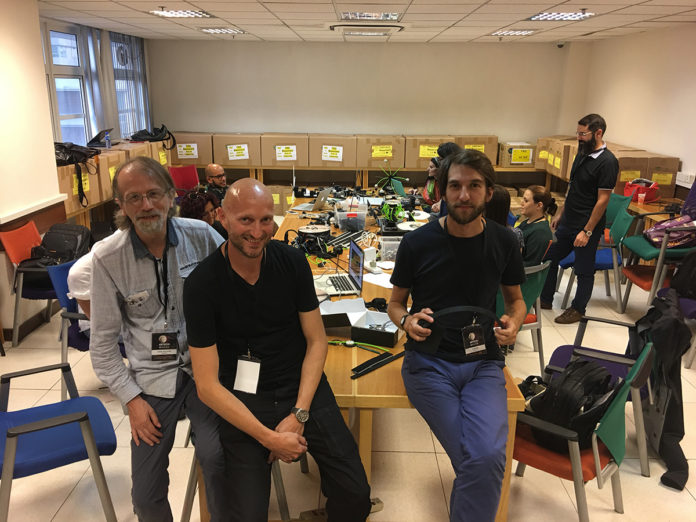Changing the way in which you understand and interact with machines, using robotics in our daily lives – in everyday objects – to dynamically interact with our environment, using robotic integration in art to teach us something about the way that we use, understand, and appreciate it. Such is the tip of the iceberg of what Samuel Bianchini, Filipe Pais and Didier Bouchon introduced their students to yesterday in a workshop entitled ‘MisB KIT WORKSHOP – A Prototyping Toolkit to Experiment with Behavioural Objects’.
Held at the University of St. Joseph’s old campus – as the institution is in the process of shifting to its new location in Ilha Verde – the workshop introduced a system involving motors which can receive wireless signals via software to perform non-traditional or task-related functions defined by their creators.
“We want to make a bridge between robotics and art and design,” explains the leader of the project, Samuel Bianchini – head of the ‘Reflective Interaction’ Research Group of the École Nationale Superiére des Arts Décoratifs in Paris.
“For us,” explains Bianchini, “it’s important to work on robotic projects without function. In this sense this kind of project [is more in the] leisure field. We are not interested in improving an object in a functional approach. One of our questions is ‘what is a new affective relationship with an object if the object could be more intelligent, could have special movement, could have reaction – but not reaction to do something – but to have a better relationship with people?’”
Bianchini, also an artist, explains the typical relationship between man-machine, noting: “If you understand action in a functional field it’s common. But if you want to understand action without this functional idea of the world, you need to take into account choreography and take into account the movement of the body. And so what kind of movement could provoke a certain relationship with the object”.
Working together with Bianchini, and leading the workshop portion of the group’s participation in the ARTECH 2017 – 8th International Conference on Digital Arts, held by the University and running until September 8, is Filipe Pais – of the same institute, who explains the importance of using this new art format properly in order to have effect.
“If you’re just using interactive or the so called ‘digital art’ – which I really don’t like because it’s making a split, it’s creating a dualism – if this kind of art is not able to reveal something about machines, then in my opinion, it’s doing nothing. Because it should actually show something to bring some light into what machines are doing to us.
“And of course while triggering this kind of experience – which sometimes is very playful, it can actually shed some light on the role of machines and how they really change our lives and how they put somehow at risk who we are and who we were.”
“We’re really interested in this form of robotics which have the shape of everyday life objects; for instance, a chair or a table that is able to move and to behave in a certain way,” explains Pais.
“It’s how to shift the relationship with the environment and to respect the environment as a living environment,” expounds Bianchini, explaining that art has a role in us understanding the symbiotic relationship with machines – laid plain to the user only once needed.
“If you need to help an object to do something, it changes completely the relationship with the object,” points out Bianchini, referring also to ‘animism’ which he hopes “to provoke experience and reflection” through interaction with the otherwise-inanimate object.
What next?
While Bianchini does not believe that these inanimate objects have, or will soon develop, consciousness, his colleague Didier Bouchon believes they can; in particular, that these interactions with the objects could develop into something deeper, with humans even falling in love with the objects themselves.
“I think it will happen, yes. But there’s a difference. We can love an animal, but it’s not a love like between a man and a woman, between people […] Robots can never be like humans, because they don’t feel the world and the relationships as we feel them. Because they don’t have the same sensation,” he says.
Pais points out that “if you look at the way you feel an affection for certain objects you have, certain things someone gave you, [you notice] we establish a very deep, symbolic relationship with inanimate things.”
“It’s not very hard to guess that we might fall in love, or we might have a certain affection for computers – just another kind of object,” opines Pais, countering, “then of course I’m not sure that computers will fall in love with you”.
Art-media
As this interaction with animism evolves, so too does the changing definition of art.
“Some people like one thing, some like others, and they must feel it themselves. We don’t need to tell them ‘this is art’,” says Bouchon in regard to acceptance of art involving robotics.
This can largely be defined by context – the main limitation behind this newer form of art being consumed in traditional settings such as museums, explains Bianchini.
“If you are in a museum and you have a lot of paintings, sculptures, photographs etc, and you have a context and a special relationship with the object: you need to be at a distance, not touch, etc. [but] if you after that you need to touch [the art piece] and be involved it completely changes the context,” he points out.
“Art has a value, and has an economical value, mostly because some of us can actually touch art because we can pay for it,” opines Pais. “But the thing is, art was always about interaction and interactivity, so this notion that interactive art – and that robotics bring interaction is totally false. Because we always establish an interactive relationship with a painting, with a Van Gogh [for example] because we move in a certain way, our eyes are actually “touching” the painting, we are actually scanning, we are moving in space. Of course the painting won’t change dynamically but it will bring us something, it will cause an effect, an impression upon us,” he notes.
“For the art market it’s very difficult to accept this kind of new art because it changes everything for the museums as well,” says Bianchini. “If you want to put an art robot in a museum it’s complicated because it’s not just an object that you can put on the wall and contemplate. It changes everything [about the experience],” he explains.
And these artists creating these dynamic, through-provoking projects cannot work alone, he continues.
“Currently, we’re all working together with an engineer – like Didier – but at the same time with cognitive science, an anthropologist, a robotician . . . It’s very important to build this kind of team for this complex subject.
And the time to mix together these different approaches and to make sense of them and to provoke experience and reflection, he notes, is now.
























